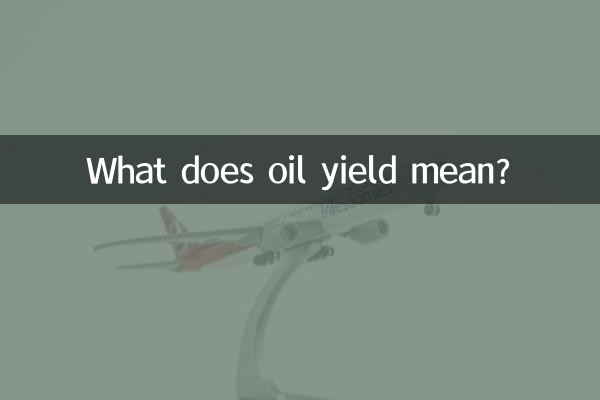What does oil yield mean?
In food processing, agriculture and industrial production, "oil yield" is a common term, but many people are not clear about its specific meaning. This article will combine the hot topics and hot content on the Internet in the past 10 days to explain in detail the definition, calculation method and practical application scenarios of oil production rate, and help readers better understand this concept through structured data.
1. Definition of oil yield rate

Oil yield refers to the efficiency of extracting oil from a certain raw material, usually expressed as a percentage. It is an important indicator to measure the oil content of raw materials and the level of processing technology, and is widely used in edible oil production, biofuel processing and other fields.
2. Calculation method of oil production rate
The calculation formula of oil yield is:
Oil yield = (weight of extracted oil / total weight of raw materials) × 100%
For example, if 100 kilograms of peanuts are pressed to obtain 45 kilograms of peanut oil, the oil yield is 45%.
3. Oil yield data of common crops
| crop name | average oil yield | Maximum oil yield |
|---|---|---|
| peanut | 45% | 50% |
| soybeans | 18% | twenty two% |
| Rapeseed | 40% | 45% |
| sunflower seeds | 42% | 50% |
| Sesame | 50% | 55% |
4. Factors affecting oil yield
1.Raw material quality: Maturity, moisture content, impurity content, etc. will all affect the oil yield.
2.Processing technology: The oil yield rates of different processes such as pressing and leaching vary greatly.
3.Equipment performance: Advanced processing equipment usually achieves higher oil yields.
4.Storage conditions: Improper storage of raw materials will cause oxidation of oil and reduce oil yield.
5. Methods to improve oil yield
1. Select high-quality raw materials to ensure maturity and freshness
2. Use advanced processing technology and equipment
3. Reasonably control processing temperature and time
4. Do a good job in raw material preprocessing, such as shelling, crushing, etc.
6. Application of oil yield in different industries
1.Edible oil industry: Oil production rate directly affects corporate costs and profits.
2.biofuel industry: The selection of high-oil crops is based on oil yield data.
3.agricultural planting: Farmers choose crops with higher economic benefits based on oil yield.
4.food processing: Fried food companies focus on oil extraction efficiency.
7. Discussion on oil yield rate in recent hot topics
1. The oil yield rate of new rapeseed varieties reaches a new high, reaching 48%
2. An edible oil company was punished for falsely advertising oil yield rate
3. Scientists develop genetically modified soybeans with higher oil content
4. Comparative study on oil yield of traditional pressing and modern leaching methods
8. The relationship between oil production rate and economic benefits
| crop | Oil yield | Market price (yuan/ton) | economic benefit index |
|---|---|---|---|
| peanut | 45% | 12,000 | 85 |
| soybeans | 18% | 6,000 | 65 |
| Rapeseed | 40% | 8,000 | 78 |
9. Future development trends
1. Breeding technology will further increase crop oil content
2. New extraction technology is expected to break through the traditional upper limit of oil yield
3. Intelligent equipment will control the oil production process more accurately
4. Environmental protection requirements will affect the formulation of oil yield standards
10. Conclusion
As an important indicator to measure the efficiency of oil extraction, oil yield is of great significance in many fields. Understanding the meaning and influencing factors of oil yield will not only help production companies improve economic benefits, but also help consumers make more informed choices. As technology advances, we expect to see the development of more oil-rich crops and the emergence of more efficient extraction methods.

check the details

check the details